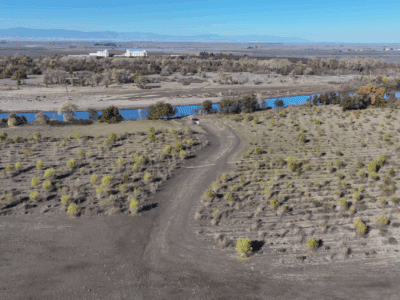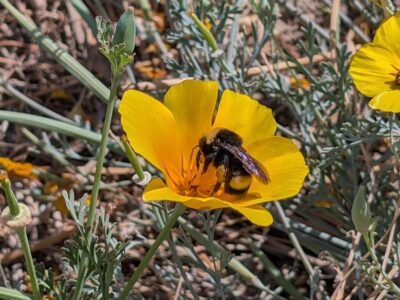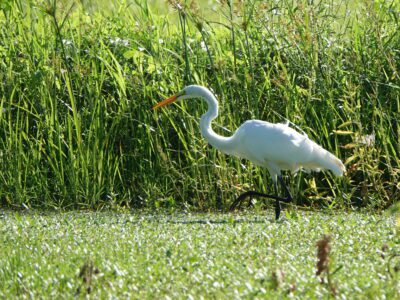Critical salmon habitat and flood safety along one of the most habitat-poor stretches of the Sacramento River are getting a boost from recent state and federal funding.
The California Department of Water Resources (DWR) funded the acquisition of approximately 1,000 acres of former farmland along the Sacramento River between Colusa and the city of Sacramento. The property, historically referred to as China Bend and what project proponents call the Turning Point Preserve, will be restored to native floodplain habitat in several phases to benefit endangered salmon and other imperiled wildlife. As part of the revitalization, the floodplain will be reconnected with the river to boost flood safety for downstream communities and recharge groundwater aquifers.
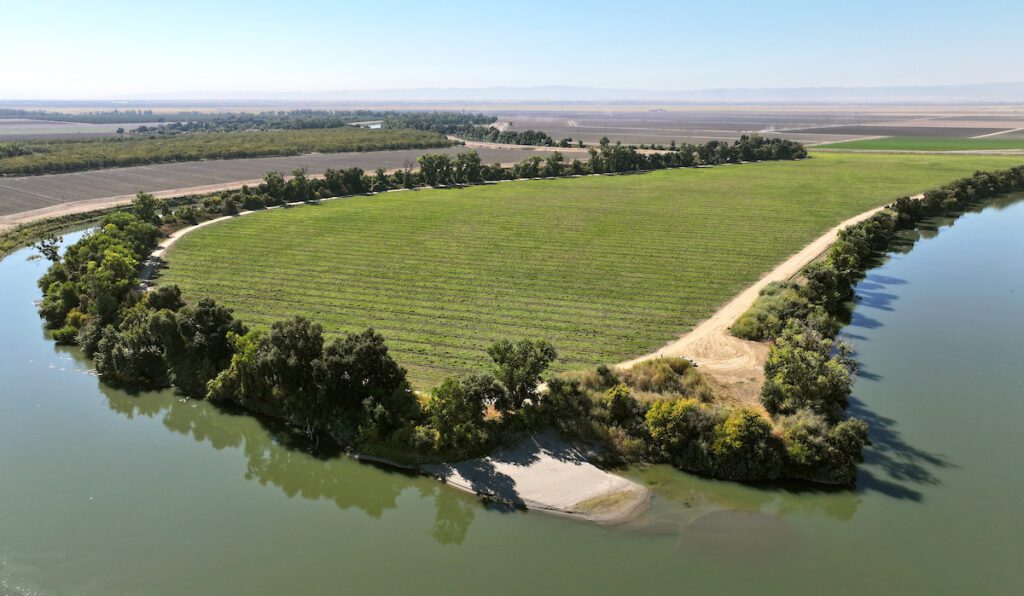
The $17.5 million acquisition was made possible through California’s Proposition 1 and DWR’s Central Valley Tributaries Program.
The U.S. Bureau of Reclamation (USBOR) also recently awarded $10 million through its Central Valley Project Improvement Act Fisheries Habitat and Facilities Improvement Program for the initial restoration of nearly 200 acres of the property into native habitat over the next five years. The first phase of restoration will begin after extensive public scoping and permitting is completed.
The statewide river-restoration nonprofit River Partners, which has restored nearly 20,000 acres of important riverside lands throughout California since its founding 25 years ago, will oversee on-the-ground restoration. American Rivers, a national organization working to protect and restore all rivers, from remote mountain streams to urban waterways, including the rivers so vital to life in California, will lead overall project management.
The effort is part of the regional Floodplain Forward initiative and coalition to expand floodplain habitat to benefit recovering salmon populations. Floodplain Forward is a public-private partnership facilitated by the Northern California Water Association which advances Sacramento Valley sustainability by enhancing and preserving water rights, supplies, and quality.
A River without a Floodplain
Historically, the Sacramento River carved its way throughout the region, continually flooding and washing away the banks restraining its course and forming new pathways. This resulted in wide and frequently inundated floodplains that were a haven for fish and other wildlife. Natural levees would form on the banks of the river, then break in storms causing unpredictable and uncontrollable inundation across lower Sacramento River basin.
Current efforts to reconnect low floodplains to river flows in the region target on-river connections like those envisioned at the Turning Point Preserve and similar restoration at nearby properties carried out by Reclamation District 108. These efforts also involve reconfiguring the system of local overflow weirs constructed over the last 150 years so they can increase the frequency and scale of water inundation to maximize benefits for salmon.
While research from the University of California, Davis, CalTrout, and the California Rice Commission shows reconnected floodplains and rice fields in the lower Sacramento River basin provide abundant food for juvenile salmon, on-river floodplain connections like those envisioned at Turning Point Preserve are the only locations where salmon can interact with these food resources in shallow, slow-moving water along their existing migration routes.
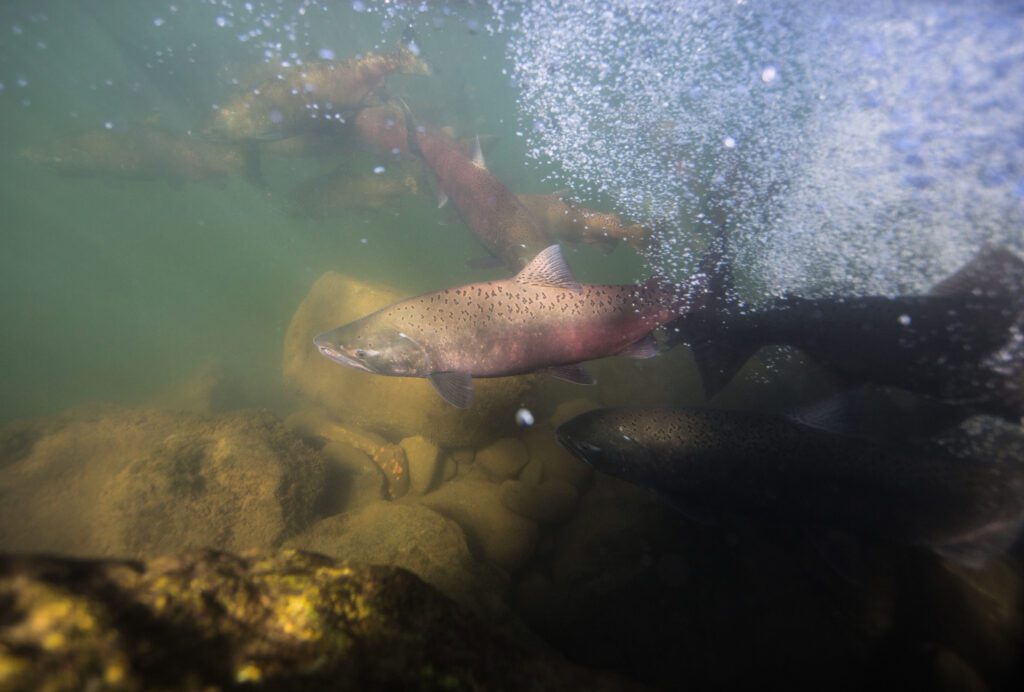
Salmon recovery is vital in sustaining agricultural industries in Northern California. Since the 1990s, local leaders across the Sacramento Valley have collaborated to envision and deliver noteworthy river restoration through the work of the Sacramento River Forum, Central Valley Flood Protection Plan and its associated Conservation Strategy, Floodplains Forward Coalition, Floodplains Reimagined program, and many others. Investment and partnership are key to making measured and careful changes to the landscape that will yield sustaining outcomes for communities and ecosystems.
Turning Point Preserve’s ultimate goal is to restore historic features of the meandering river for both ecological and community benefits. It complements noteworthy public and private conservation efforts—including California’s 30×30 initiative, the multi-stakeholder Sacramento River Salmon Recovery Program, and the recently updated Central Valley Flood Protection Plan—to restore thousands of acres of riverside habitat throughout the Sacramento River system over the next several decades.
DWR’s investments in projects like Turning Point Preserve will help ensure endangered species have more habitat to thrive, local groundwater basins have stronger ability to recover after periods of extreme drought, and vulnerable communities have increased flood protection.
Karla Nemeth, Director, California Department of Water Resources
“DWR’s investments in projects like Turning Point Preserve will help ensure endangered species have more habitat to thrive, local groundwater basins have stronger ability to recover after periods of extreme drought, and vulnerable communities have increased flood protection,” said Karla Nemeth, Director of the California Department of Water Resources. “That’s also why the Newsom administration, in partnership with the Legislature, has invested more than $430 million in the most recent budget to support flood response and projects to protect communities from future flooding.”
A Boon for Struggling Salmon, Wildlife
The first of several phases of restoration, which is set to begin in December, includes restoring two large and adjacent floodplain areas totaling nearly 200 acres with thousands of native trees, plants, and grasses. This includes native vegetation such as willows and sedges used by area Native American Tribes to make baskets, tools, traditional foods, and other culturally significant items.
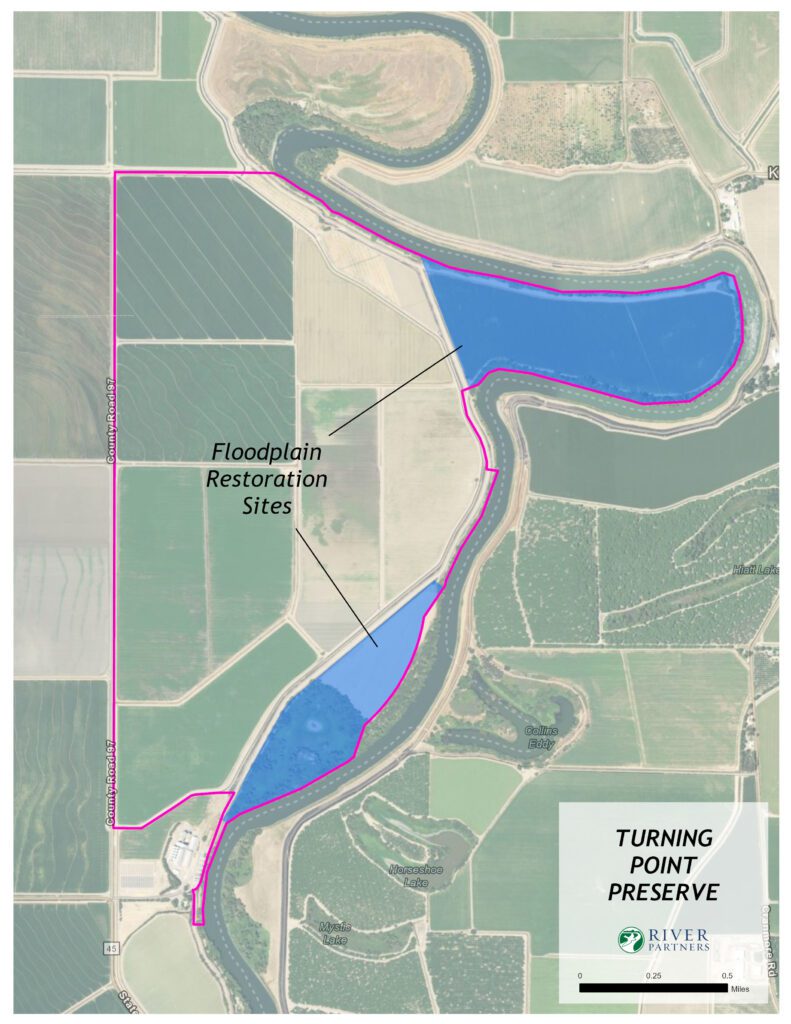
Revitalizing the sites will also involve breaching agricultural berms built along the edge of the property over the last century, connecting the sites directly to the Sacramento River. Doing so will create seasonal inundation of the floodplains to increase beneficial salmon habitat and provide shelter from predators and high, fast-moving river flows.
A major factor determining a salmon’s survival once it reaches the ocean is how big it is. The restored floodplains at Turning Point Preserve will boost food supplies both on the floodplain and in the main river channel, helping fish quickly grow in size and migrate through this last, perilous stretch of the Sacramento River to the Pacific Ocean where they will live for up to three years before migrating back up the river to spawn.
Populations of winter-run Chinook salmon in the Sacramento River have dropped by 90% over the last 40 years due in large part to extensive river channelization. The project will benefit all four endangered Central Valley Chinook salmon runs, Central Valley steelhead, Sacramento splittail, and other struggling fish species.
Reconnection of the river to the floodplain will also increase available habitat and food for native riparian birds like the threatened Swainson’s hawk, migratory shorebirds, millions of waterfowl that migrate along the Pacific Flyway each year, and important pollinators such as bees and monarch butterflies.
Communities need better flood protection, and endangered fish and wildlife need better habitat. When we work with nature, not against it, we can deliver a lot of benefits for communities, the environment, and the economy in the face of increasing climate impacts.
Sarah Puckett, Central Valley Program Director, American Rivers
“This project demonstrates how restoring a river is a cost-effective way to solve multiple problems at once,” said Sarah Puckett, Central Valley Program Director for American Rivers. “Communities need better flood protection, and endangered fish and wildlife need better habitat. When we work with nature, not against it, we can deliver a lot of benefits for communities, the environment, and the economy in the face of increasing climate impacts.”
Increased Flood Safety, Water Supplies
Due to California’s changing climate, scientists predict a three- to nearly five-fold increase in flooding along the state’s major waterways, including the Sacramento River.
There’s incredible potential to make Turning Point Preserve a statewide model of floodplain restoration that pays big dividends for thriving ecosystems and communities in the face of climate change.
Julie Rentner, President, River Partners
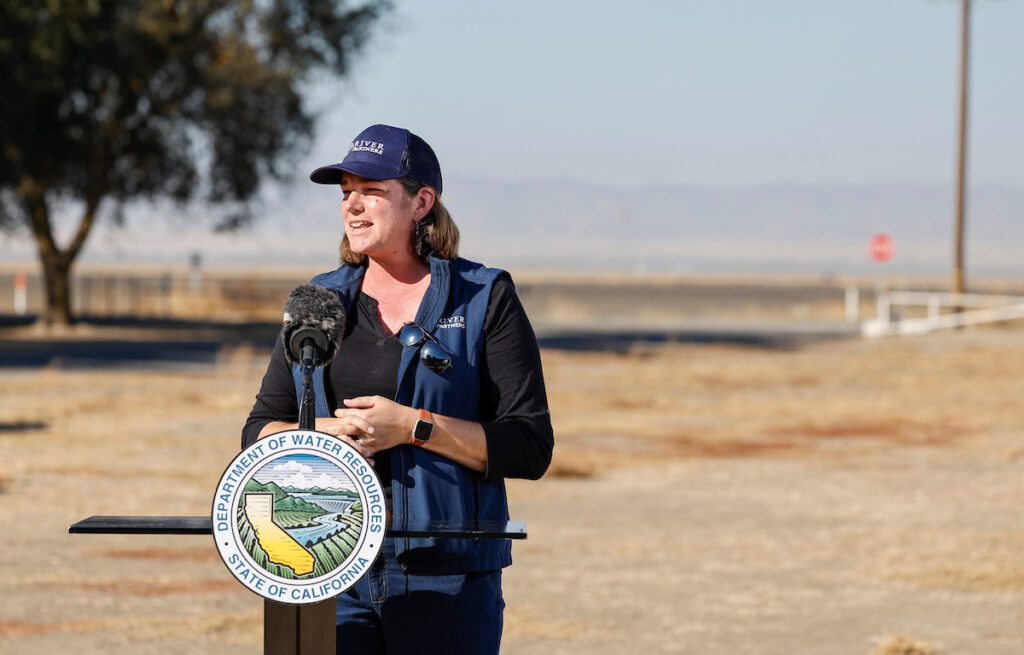
Removing and modifying the existing berms at Turning Point Preserve may improve flood safety for downstream communities by allowing floodwaters to spread out, slow down, and sink into the newly created floodplains. This will lower floodwater levels and reduce pressure on vulnerable levees both upstream and downstream. The project supports DWR’s Small Communities Flood Risk Reduction Program and future efforts to improve flood safety in and around Knights Landing, an underserved community that lies roughly 15 miles south of the project that has a long history of flooding.
Allowing more river water to sink into the ground may also help recharge local groundwater supplies important for agricultural and household use.
More Restoration on the Horizon
Over the coming years, project partners will engage in wholistic project planning and scoping to maximize benefits for the entire region and take advantage of near-term opportunities to improve conditions for salmon. Additional phases of restoration at Turning Point Preserve over the next decade may include:
- Restoring an additional 800 acres on the property
- Potentially acquiring and restoring up to 2,000 acres of additional land around the preserve to expand restoration benefits
- Studying the benefits of additional levee modifications at other locations on the property, which current scientific modeling indicates may boost flood safety for both upstream and downstream communities
- Opening the property to the public for recreation, including potentially installing a non-motorized boat launch
- Ultimately transferring the land to a local Tribe(s) or state or federal agencies for long-term management
“There’s incredible potential to make Turning Point Preserve a statewide model of floodplain restoration that pays big dividends for thriving ecosystems and communities in the face of climate change,” said Julie Rentner, President of River Partners. “DWR and the U.S. Bureau of Reclamation are leading the way in demonstrating the power of revived riverways in delivering a brighter future for everything that makes California so special.”
Farming operations on the remaining 800 acres of the property will continue for up to 10 years before being restored.
About the Department of Water Resources
DWR is responsible for managing and protecting California’s water resources and works with others to benefit the State’s people and to protect, restore, and enhance the natural and human environments. DWR operates and maintains the State Water Project, oversees dam safety, provides flood protection, helps in emergency response, assists regional and local water agencies, promotes water conservation and safety, and plans integrated watershed management – in all to advance water resource sustainability. For more information, follow DWR on Twitter or Facebook and read our news releases and DWR updates.
About American Rivers
American Rivers is championing a national effort to protect and restore all rivers, from remote mountain streams to urban waterways. Healthy rivers provide people and nature with clean, abundant water and natural habitat. For 50 years, American Rivers staff, supporters, and partners have shared a common belief: Life Depends on Rivers. www.americanrivers.org
About River Partners
River Partners brings life back to California’s rivers. Founded in 1998, the nonprofit harnesses the power of restored riverways to create a thriving future for the state’s environment and communities. Blending modern farming practices, cutting-edge science, and diverse alliances, River Partners reforests and reconnects entire river landscapes, critical wildlife corridors, and vast ecological regions at a bold pace and scale. The organization’s statewide efforts result in lasting, tangible wins for wildlife, flood safety, climate resiliency, water conservation, healthy communities, and local economies. River Partners has the largest on-the-ground restoration footprint of any nonprofit or firm in the western U.S., having led hundreds of large-scale projects across more than 18,000 acres throughout California. www.riverpartners.org


